 Image search results - "yamagata" Image search results - "yamagata" |
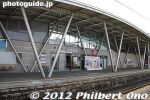
JR Akayu Station on the Yamagata or Ou Line. The Yamagata shinkansen also stops here.
|
|
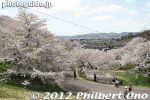
Eboshiyama Park is one of Japan's 100 Famous Cherry Blossom Spots. The hillside park is full of spectacular cherry trees and pine trees.
|
|
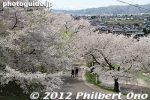
The path from the parking lot leading to the park is also full of cherry blossoms greeting visitors right off the bat.
|
|

The park is a short taxi ride from JR Akayu Station on the Yamagata/Ou Line.
|
|
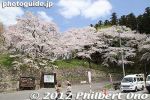
Eboshiyama Park parking lot.
|
|
|
|
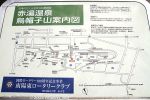
Map of Eboshiyama Park. The right side of the map shows the park full of cherry trees, while the left side is mainly Eboshiyama Hachimangu Shrine.
|
|
|
|
|
|
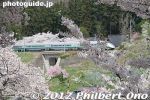
Yamagata shinkansen speeds past Eboshiyama.
|
|
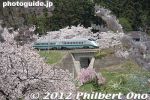
Yamagata shinkansen speeds past Eboshiyama.
|
|

This is what Eboshiyama Park looks like from the train.
|
|
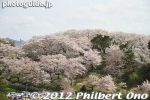
This is what Eboshiyama Park looks like from the train. This is the north side of the park. The south side is similar to this.
|
|
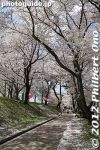
The park has an elliptical path going around the hill.
|
|
|
|
|
|
|
|
|
|
|
|
|
|
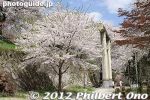
Adjacent to the park is Eboshiyama Hachimangu Shrine with Japan's largest stone torii gate.
|
|

Also called Tsukioka Castle (月岡城), Kaminoyama Castle is today a 1982 reconstruction of the castle tower near the original site. The castle as seen from the train.
|
|

Kaminoyama Onsen Station is the closest train station to Kaminoyama Castle. The station building is obviously designed after the castle.
|
|

Kaminoyama Onsen Station
|
|

Welcome to Kaminoyama Onsen (spa).
|
|

Kaminoyama Onsen Station used to be called Kaminoyama Station. The station's name was changed to Kaminoyama Onsen after the Yamagata Shinkansen was completed in 1992. This building was completed in June 1994.
|
|

Even the police box (koban) near the Kaminoyama Onsen train station is designed after the castle.
|
|

Kaminoyama's manhole design does not have a castle motif. Yamagata Pref.
|
|

Kaminoyama Castle in sight.
|
|

Way to Kaminoyama Castle. About a 10-min. walk from the train station.
|
|
|

Marker showing the former site of Kaminoyama City Hall. This is already within the former castle grounds.
|
|

The castle and the area surrounding it is a park called Tsukioka Park.
|
|

Kaminoyama Castle, Yamagata Pref. The building is four stories high reconstructed in Nov. 1982. The design is based on the castle existing in 1535.
|
|

Admission 400 yen.Open 9 am to 4:45 pm. Closed in late Dec. and early Jan. and during the third week of July from Mon. to Fri.
|
|

Kaminoyama Castle's first lord was Buei Yoshitada. The castle functioned as the Mogami clan's southernmost defense against the Date and Uesugi clans. The castle was dismantled in 1692.
|
|
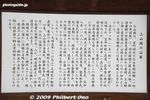
About Kaminoyama Castle in Japanese.
|
|

Top floor of Kaminoyama Castle leads to the veranda. Photography is not allowed inside the castle building.
|
|

Veranda of Kaminoyama Castle.
|
|

View from Kaminoyama Castle's top floor. It was a cloudy day when I visited.
|
|

Looking toward Yamagata city.
|
|

Yamagata shinkansen stops at Kaminoyama Onsen Station.
|
|

Kaminoyama Onsen Station. The tall building is in neighboring city Yamagata.
|
|

The small building near the center is a foot bath shed.
|
|

Tsukioka Park
|
|

Next to Kaminoyama Castle is this foot bath with hot spring water.
|
|

The foot bath at Kaminoyama Castle looks very inviting, but the water was scalding hot when I was there. I got mild skin burns on my feet. You don't ever think that the water is too hot. All the foot baths I've tried were all suitable temperatures
|
|

Kaminoyama Castle and foot bath. This is the only foot bath in Japan which was too hot. Before entering an empty foot bath, feel the water temperature with your hand.
|
|

Another foot bath nearer to the Kaminoyama Onsen Station. This was also scalding hot.
|
|

Yamagata Castle is closest to JR Yamagata Station. This is the east side. The train station and surrounding area changed a lot since my first visit years ago.
|
|

Bus stop in front Yamagata Station.
|
|

In front Yamagata Station on the east side.
|
|

In front Yamagata Station on the west side. I wonder what that prime space will be used for. The tall buildings are hotels.
|
|

On the west side of Yamagata Station is a skyscraper called Kajo Central which has also greatly contributed to the urban development of Yamagata city. A high school is in this building as well.
|
|

On the ground floor is a nice Yamagata Prefecture tourist office. Pick up pamphlets and other info here. The building is connected to Yamagata Station by a corridor.
|
|

When I was there in Aug. 2009, the lobby of Kajo Central had the interesting Art Chair Project. Elementary and intermediate school students in Yamagata Pref. competed in a design competition for art chairs, and the winners' works are displayed here.
|
|

The lobby featured chairs and benches with novel motifs. This seemed to be the most popular, sitting in a bowl of potato soup.
|
|

Grapes to sit on. Kajo Central lobby, Yamagata.
|
|

A pear perhaps.
|
|

Rice plant
|
|

Dish bench?
|
|

Kajo Central also has a lookout deck on one of the top floors.
|
|

View of Yamagata on the east side of Yamagata Station as seen from Kajo Central.
|
|

Yamagata Station
|
|

West side of Yamagata Station. Look at all that land right in front of the station.
|
|
|

Kajo Park as seen from Kajo Central. Kajo Park is the site of Yamagata Castle, also called Kajo or Kasumigajo Castle which means Misty Castle.
|
|

Kajo Park as seen from Kajo Central. During the Battle of Hasedo in 1600 between Mogami Yoshiaki and Naoe Kanetsugu, Yamagata Castle was hidden by mist. Hence, the nickname.
|
|

Map of central Yamagata city. The top-most road in bold leading to the former prefectural office is where the Hanagasa Matsuri parade is held in early Aug. Yamagata Castle (Kajo Park) is on the west side of the train station.
|
|

A short walk from Kajo Central is Kajo Park. You can enter the park through the South Gate or the slightly further Ninomaru Higashi Otemon Gate here. This is the main entrance. Free admission.
|
|

Southern turret on left side of Ninomaru Higashi Otemon Gate. This turret is open to the public.
|
|

Yamagata Castle's Ninomaru Higashi Otemon Gate. This gate and turret were accurately reconstructed in 1991 based on Edo Period documents and Meiji Period photos. 二の丸東大手門
|
|

Turret on right side of Ninomaru Higashi Otemon Gate. It took 3 years and 9 months and 1.1 billion yen to reconstruct the gate and turrets. It was in 1978 when they decided to reconstruct the gate and turrets. They moved and brought in many tons of stone.
|
|

Left side of Ninomaru Higashi Otemon Gate. The train line passes through.
|
|

Moat on right side of Ninomaru Higashi Otemon Gate.
|
|
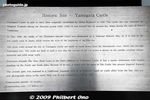
About Yamagata Castle in English. Yamagata Castle was first built in 1356 by Shiba Kaneyori (斯波 兼頼) who moved to Yamagata. He became the first lord in the Mogami Clan. His most famous descendant, Lord Mogami Yoshiaki built up the castle in 1592-15
|
|

Map of Kajo Koen Park. 霞城公園
|
|

Ninomaru Higashi Otemon Gate leads to the Ninomaru keep which is a National Historic Site.
|
|

Northern turret.
|
|

Another gate at the Ninomaru Higashi Otemon Gate
|
|
|

Ninomaru Higashi Otemon Gate
|
|

The stones on the wall have cutting marks.
|
|

Behind the Ninomaru Higashi Otemon Gate is a large statue of Lord Mogami Yoshiaki.
|
|
|

Behind Ninomaru Higashi Otemon Gate
|
|

Statue of Mogami Yoshiaki who was the daimyo lord of Yamagata in the late 16th century and early 17th century. Statue constructed in 1977. 最上義光
|
|

Statue of Mogami Yoshiaki depicting him taking the lead to the battlefield against Naoe Kanetsugu. 最上義光
|
|

The park has other gates (north, south, and west) and monuments, but I didn't have time to see all of them. I exited the park through the South Gate (photos below).
|
|

Steps to the entrance of the turret.
|
|

At the top of the steps, the castle wall.
|
|
|
|

Inside the Ninomaru Higashi Otemon Gate turret at Yamagata Castle. Very impressive construction. Still new-looking even after almost 20 years.
|
|

They had a few exhibits and a video of the castle.
|
|
|

Slits in the floor to drop stones and arrows.
|
|

Slit in the floor to drop stones and arrows.
|
|
|
|

View of Ninomaru Higashi Otemon Gate's bridge.
|
|
|

Walk further and you will reach Honmaru central keep. This Honmaru bridge was accurately reconstructed in 2006.
|
|

This Honmaru bridge was accurately reconstructed in 2006. The stonework was also reconstructed in 2004. 大手橋
|
|

They want to also reconstruct buildings on the stone foundations seen here. The problem is, they don't have accurate records of what the floor plan and buildings looked like in the 18th-19th century. They are calling on the public for any old photos.
|
|

Artist's rendition of what the completed reconstruction will look like.
|
|

We can walk on the bridge to the Honmaru. 大手橋
|
|

Moat on the right side of the bridge.
|
|

Honmaru gate 本丸一文字門
|
|

This area in the Honmaru was the site of the castle palace.
|
|

They want to build an outline of the palace in the Honmaru.
|
|

Still renovating the stone walls.
|
|

Since it is a National Historic Site, the city is taking steps to revert the park into a historical site by eliminating most of the existing sports facilities (gym, baseball diamond, etc.). Should look like this.
|
|

A scale model of Yamagata Castle as it looked in the 18th century. (Displayed in the Kyodokan Museum.)
|
|

In Kajo Park is Yamagata City Kyodokan Museum that displays mainly medical-related exhibits. The building is an Important Cultural Property. 山形市郷土館
|
|

Formerly called Saiseikan (済生館), it originally was a private hospital established in 1873. It used to be located near the prefectural capital. It was moved here in 1969.
|
|

In 1971, it became the museum that it is today. Free admission. Enter the building in the back. Open 9 am to 4:30 pm. Closed in late Dec. and early Jan.
|
|

It is a round building, with a Japanese garden in the middle.
|
|

The rooms now are exhibition rooms showing mainly medical-related pictures and surgical instruments.
|
|

Room exhibiting Albrecht Von Roretz, an Austrian doctor who served as the director of the Saiseikan Hospital. If you're a doctor or interested in medical treatment history, you will like this museum.
|
|

It also shows various surgical instruments used in the old days.
|
|

Stairs to the second floor.
|
|

Spiral staircase to the tower (closed to the public).
|
|

Second floor has more exhibits.
|
|
|
|
|
|

Medical drawing showing pregnant Japanese women.
|
|

Monument for Albrecht Von Roretz, an Austrian doctor who served as the director of the Saiseikan Hospital and contributed to promoting Western medicine in Japan during the early Meiji Period.
|
|

Yamagata Prefectural Museum also in Kajo Park.
|
|

Yamagata Castle's South Gate, closest to Yamagata Station. 南門
|
|
|

Moat next to South Gate.
|
|
|

Yamagata Castle moat next to South Gate.
|
|
|

South Gate. Similar stone work and moats can be seen at the Nishi (West) and Kita (North) Gates.
|
|

Banner for Mogami Yoshiaki.
|
|

PR poster for Tenchi-nin, TV series about Naoe Kanetsugu aired on NHK in 2009.
|
|
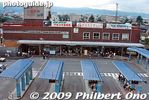
Old Yamagata Station.
|
|
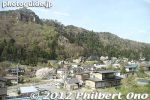
Yamadera is mountain temple perched on a steep cliff near JR Yamadera Station.
|
|
|
|
|
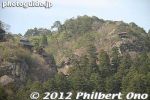
Yamadera temple, Yamagata
|
|
|
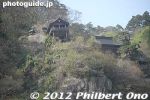
Yamadera temple, Yamagata
|
|

During early Aug., JR Yamagata Station has a Hanagasa Matsuri billboard above the turnstile as you get out.
|
|

Yamagata Station also has a Hanagasa info counter set up during the festival. You can pick up a map of the parade route.
|
|

Yamagata Station's exit has hanagasa (flower hat) decorations.
|
|

You can buy your own hanagasa and join in the festival.
|
|

Held since 1963, the Yamagata Hanagasa Matsuri festival is held annually during Aug. 5-7. It is an evening parade of dancers using a hanagasa (flower hat) held during the three evenings from 6 pm to 9:30 pm.
|
|

When I arrived during lunch time on Aug. 7, 2009, a group of hanagasa dancers held a PR demonstration right inside Yamagata Station as you see here.
|
|

It is a folk dance characterized by the hanagasa, or flower hat, which is held with both hands and swung left and right, above the head, etc. The festival originated as a rice-planting prayer for a good harvest.
|
|

They dance to the beat of taiko drums and the prerecorded folk tune of Hanagasa Ondo singing, "Yassho, makasho!"
|
|

The artificial red flowers on the hats symbolize the safflower, the city flower.
|
|

It's possible to stopover in Sendai and take a day trip to Yamagata to see this festival. However, if you want to stopover in Yamagata during the Hanagasa Festival, make reservations early especially for budget hotels.
|
|
|

Yamagata Hanagasa Matsuri
|
|

My video of Yamagata Hanagasa Matsuri in Aug. 2009.
|
|

By 5:30 pm, a good crowd of people lined the parade street stretching for 1.2 km. The parade route is a 10-15-min. walk from Yamagata Station. It was lot more crowded than the first time I saw this festival years ago.
|
|

The parade starts at 6 pm, and it took about 10 min. to reach where I was.
|
|

A total of about 120 groups (10,000 people) dance over the three evenings. If you want to see a certain group, you'll have to check the parade schedule. Also, a different celebrity guest also dances each evening.
|
|
|
|
|
|

Paper lanterns written with "Yama-gata-hana-gasa-ma-tsu-ri."
|
|

Sometimes we see floats.
|
|

This is one of the main and best dance groups. They all dance to a song called "Hanagasa Ondo." A recording of the song is repeated continuously through the loudpseakers. 花笠音頭
|
|

The first few groups of dancers were the best.
|
|
|
|

Lovely Yamagata hanagasa dancer.
|
|

Photogenic Yamagata hanagasa dancer.
|
|

An average of 300,000 tourists watch the parade per evening.
|
|

Yamagata Hanagasa Matsuri
|
|
|
|
|
|
|

Miss Hanagasa 2009. There are four of them.
|
|
|
|

Many dance groups were sponsored by large companies, and the company name or logo was prominently displayed on the clothing. It really is a long advertising parade.
|
|

I don't mind advertising, but I was upset to see a 100-meter long dance group advertising a phone company. They thus took a long time to pass by. (No photos of them here.)
|
|
|
|

School kids were also in the parade.
|
|

Female taiko drummers on trucks.
|
|
|
|
|
|
|
|
|
|
|
|

This is at the end of the parade route which had a nice illuminated gate overhead.
|
|
|
|
|
|
|
|

It was drizzling off and on, so the road was wet. The shiny road made the shot look more dramatic together with the backlight.
|
|
|
|
|
|
|
|
|
|
|
|
|
|

Cheerleaders too
|
|
|
|
|
|
|
|
|
|
|
|
|

It was a good size crowd despite the drizzling rain, but it wasn't not horrendously crowded. It was pretty easy to get around and find a new spot to watch the parade.
|
|

Yamagata maiko
|
|

Yamagata maiko
|
|

This is actress Eri Watanabe (b. 1955) who is from Yamagata. She gave a memorable performance in the 1996 movie, "Shall We Dance?"
|
|

Actress Eri Watanabe in Yamagata Hanagasa Matsuri on Aug. 7, 2009.
|
|
|
|

Military-style male dancers.
|
|

Miss Hanagasa
|
|
|

Then there was this group of sexy Yamagata hanagasa dancers. Holy smoke, look at that cleavage, something you never see with a yukata.
|
|

Miniskirted yukata
|
|
|
|

The final group was led by the four Miss Hanagasa. Anybody could dance in this final group.
|
|
|

Miss Hanagasa 2009.
|
|

Miss Hanagasa 2009.
|
|

Amateur hanagasa dancers.
|
|

"See you next year." The parade ends at around 9:30 pm at the end of the parade route. But it ends earlier if you are at the midway point instead. There was enough time for me to catch the last train back to Sendai at 9:46 pm.
|
|

Cop cars block the parade road.
|
|

Yonezawa Station platform on the JR Yamagata shinkansen.
|
|

Inside Yonezawa Station in spring.
|
|
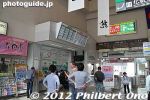
Inside Yonezawa Station.
|
|
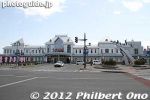
JR Yonezawa Station in spring.
|
|
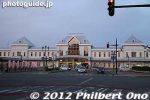
JR Yonezawa Station in spring.
|
|
|
|